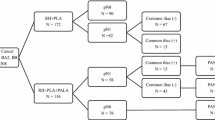Abstract
Purpose
To investigate whether the total number of removed lymph nodes (LNs) and the number of metastatic LNs would prove to be independent prognostic factors for survival in patients with cervical cancer (CC).
Methods
Data from patients with CC who underwent radical surgery between March 1980 and September 2009 were reviewed. A total of 526 patients were included in the statistical analysis. Full pathologic evaluation was performed. The total number of examined LNs and their histopathological status were analyzed for their prognostic effect on survival by means of multivariable Cox proportional hazard regression models.
Results
The median number (interquartile range) of total, pelvic, and para-aortic nodes removed was 37 (29–47), 34 (27–42), and 19 (14–24), respectively. Positive pelvic nodes were found in 102 of 526 (19 %) patients. All 8 patients with para-aortic metastases had also pelvic node metastases. At multivariable analysis, vaginal involvement, type of lymphadenectomy and LN status all significantly negatively affected disease-free survival and overall survival, whereas the number of total LNs removed did not affect survival.
Conclusions
LN metastasis and number of LN metastases confer an independent risk for worse survival in patients with CC. Pelvic lymphadenectomy is important for staging and regional disease control when LNs are involved. If a standardized complete lymphadenectomy is performed, the number of LNs is not a significant factor per se.

Similar content being viewed by others
References
Sakuragi N. Up-to-date management of lymph node metastasis and the role of tailored lymphadenectomy in cervical cancer. Int J Clin Oncol. 2007;12:165–75.
Pieterse QD, Kenter GG, Gaarenstroom KN, et al. The number of pelvic lymph nodes in the quality control and prognosis of radical hysterectomy for the treatment of cervical cancer. Eur J Surg Oncol. 2007;33:216–21.
Verleye L, Vergote I, Reed N, Ottevanger PB. Quality assurance for radical hysterectomy for cervical cancer: the view of the European Organization for Research and Treatment of Cancer–Gynecological Cancer Group (EORTC-GCG). Ann Oncol. 2009;20:1631–8.
Landoni F, Maneo A, Zapardiel I, Zanagnolo V, Mangioni C. Class I versus class III radical hysterectomy in stage IB1–IIA cervical cancer. A prospective randomized study. Eur J Surg Oncol. 2012;38:203–9.
Sedlis A, Bundy BN, Rotman MZ, Lentz SS, Muderspach LI, Zaino RJ. A randomized trial of pelvic radiation therapy versus no further therapy in selected patients with stage IB carcinoma of the cervix after radical hysterectomy and pelvic lymphadenectomy: a Gynecologic Oncology Group study. Gynecol Oncol. 1999;73:177–83.
Zanaboni F, Grijuela B, Giudici S, et al. Weekly topotecan and cisplatin (TOPOCIS) as neo-adjuvant chemotherapy for locally-advanced squamous cervical carcinoma: results of a phase II multicentric study. Eur J Cancer. 2013;49:1065–72.
Raspagliesi F, Ditto A, Selvaggi L, et al. A phase 2 multicenter study of irinotecan and cisplatinum as neoadjuvant treatment in patients with locally advanced cervical cancer. Int J Gynecol Cancer. 2010;20:1569–75.
Lissoni AA, Colombo N, Pellegrino A, et al. A phase II, randomized trial of neo-adjuvant chemotherapy comparing a three-drug combination of paclitaxel, ifosfamide, and cisplatin (TIP) versus paclitaxel and cisplatin (TP) followed by radical surgery in patients with locally advanced squamous cell cervical carcinoma: the Snap-02 Italian Collaborative Study. Ann Oncol. 2009;20:660–5.
Quinn MA, Benedet JL, Odicino F, et al. Carcinoma of the cervix uteri. FIGO 26th annual report on the results of treatment in gynecological cancer. Int J Gynaecol Obstet. 2006;95(Suppl 1):S43–103.
Shah M, Lewin SN, Deutsch I, et al. Therapeutic role of lymphadenectomy for cervical cancer. Cancer. 2011;117:310–7.
Lai CH, Chang HC, Chang TC, et al. Prognostic factors and impacts of adjuvant therapy in early-stage cervical carcinoma with pelvic node metastases. Gynecol Oncol. 1993;51:390–6.
Sakuragi N, Satoh C, Takeda N, et al. Incidence and distribution pattern of pelvic and paraaortic lymph node metastasis in stages IB, IIA and IIB cervical carcinoma treated with radical hysterectomy. Cancer. 1999 1;85:1547–54.
Inoue T, Morita K. The prognostic signifi cance of number of positive nodes in cervical carcinoma stages IB, IIA, and IIB. Cancer. 1990;65:1923–7.
Kamura T, Tsukamoto N, Tsuruchi N, et al. Histopathologic prognostic factors in stage IIb cervical carcinoma treated with radical hysterectomy and pelvic-node dissection—an analysis with mathematical statistics. Int J Gynecol Cancer. 1993;3:219–25.
Park TK, Kwon JY, Kim SW, Kim SH, Kim SN, Kim GE. Patterns of treatment failure following radiotherapy with combination chemotherapy for patients with high-risk stage IIB cervical carcinoma. Int J Clin Oncol. 2004;9:120–4.
Cady B. Lymph node metastases. Indicators, but not governors of survival. Arch Surg. 1984;119:1067–72.
Disclosure
The authors declare no conflict of interest.
Author information
Authors and Affiliations
Corresponding author
Rights and permissions
About this article
Cite this article
Ditto, A., Martinelli, F., Lo Vullo, S. et al. The Role of Lymphadenectomy in Cervical Cancer Patients: The Significance of the Number and the Status of Lymph Nodes Removed in 526 Cases Treated in a Single Institution. Ann Surg Oncol 20, 3948–3954 (2013). https://doi.org/10.1245/s10434-013-3067-6
Received:
Published:
Issue Date:
DOI: https://doi.org/10.1245/s10434-013-3067-6



